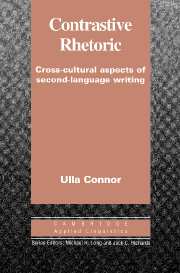Series editors' preface
Published online by Cambridge University Press: 05 October 2012
Summary
The influence of the learner's first language on the acquisition and use of a second has long been a focus of interest within applied linguistics. Much of this work has been confined to the sentence or utterance level and has explored both the linguistic and psycholinguistic aspects of the processes involved. The field of contrastive rhetoric, by comparison, extends and broadens this area of inquiry to the levels of discourse and text. Its areas of focus are the role of first language conventions of discourse and rhetorical structure on second language usage, as well as cognitive and cultural dimensions of transfer, particularly in relation to writing. The expanding discipline of contrastive rhetoric studies is hence of considerable interest to the field of second language learning and teaching, particularly to those involved in teaching composition and English for Specific Purposes.
It is this approach to the study of second language literacy which is presented in Ulla Connor's comprehensive introduction to the field of contrastive rhetoric, as she defines the outer boundaries of the field. Drawing on a wide and interdisciplinary body of theory and research, Connor traces the history of contrastive approaches to the study of second language writing and explores the interfaces between contrastive rhetoric and other disciplines, including composition studies, translation, text linguistics, genre analysis, and cultural anthropology. She demonstrates, with examples from a wide variety of languages, how second language writers draw on a range of cross-linguistic and cross-cultural influences at both the sentence, paragraph, and textual level.
- Type
- Chapter
- Information
- Contrastive RhetoricCross-Cultural Aspects of Second Language Writing, pp. xi - xiiPublisher: Cambridge University PressPrint publication year: 1996



